

Web Content Accessibility Guidelines (WCAG) 2.0. This publication has been funded in part with Federal funds from the U.S.
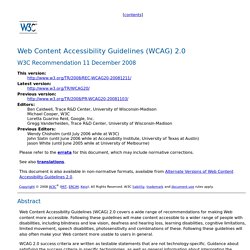
Department of Education, National Institute on Disability and Rehabilitation Research (NIDRR) under contract number ED05CO0039. The content of this publication does not necessarily reflect the views or policies of the U.S. Department of Education, nor does mention of trade names, commercial products, or organizations imply endorsement by the U.S. Government. Additional information about participation in the Web Content Accessibility Guidelines Working Group (WCAG WG) can be found on the Working Group home page. How to Meet WCAG 2.0. This web page can be used as a checklist for WCAG 2.0.

It provides: All of the requirements (called "success criteria") from Web Content Accessibility Guidelines (WCAG) 2.0Techniques to meet the requirements, which are linked to pages with descriptions, code examples, browser and assistive technology support notes, and tests.Failures to avoid, which are linked to pages with descriptions, examples, and tests. "Understanding" links to pages that explain the intent of the guideline or success criterion, how it helps people with different disabilities, key terms, and resources. How to Meet WCAG 2.0. Web Content Accessibility Guidelines (WCAG) 2.0. This publication has been funded in part with Federal funds from the U.S.
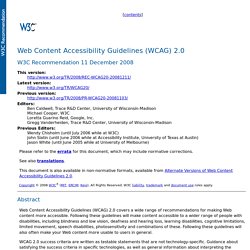
Department of Education, National Institute on Disability and Rehabilitation Research (NIDRR) under contract number ED05CO0039. How to Meet WCAG 2.0. Web Accessibility Initiative (WAI) - home page. RTC Accessibility User Requirements (RAUR) Note Published RTC Accessibility User Requirements (RAUR) is published as a Working Group Note.
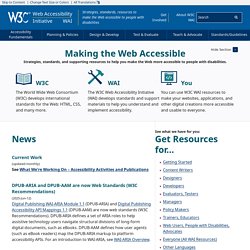
Developing a Web Accessibility Business Case for Your Organization: Overview. In-Suite Navigation This page is the first of five web pages covering the social, technical, financial, and legal and policy factors in the business case for Web accessibility.
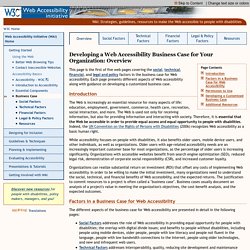
Each page presents different aspects of Web accessibility along with guidance on developing a customized business case. Introduction The Web is increasingly an essential resource for many aspects of life: education, employment, government, commerce, health care, recreation, social interaction, and more. Policies Relating to Web Accessibility - WAI. W3C QA - How to achieve Web standards and quality on your Web site? Status This article has been produced as part of the W3C Quality Assurance Interest Group work.
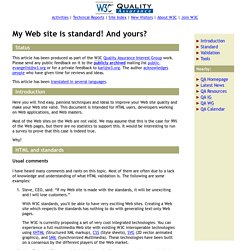
Please send any public feedback on it to the publicly archived mailing list public-evangelist@w3.org or for a private feedback to karl@w3.org. The author acknowledges people who have given time for reviews and ideas. This article has been translated in several languages. Introduction. Standards. W3C standards define an Open Web Platform for application development that has the unprecedented potential to enable developers to build rich interactive experiences, powered by vast data stores, that are available on any device.
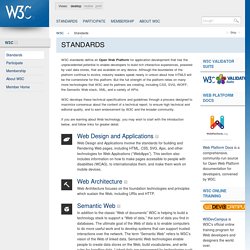
Although the boundaries of the platform continue to evolve, industry leaders speak nearly in unison about how HTML5 will be the cornerstone for this platform. But the full strength of the platform relies on many more technologies that W3C and its partners are creating, including CSS, SVG, WOFF, the Semantic Web stack, XML, and a variety of APIs. Future Media Standards & Guidelines - Home Page. Web Design and Applications. The W3C needs to make sure that the typographic needs of scripts and languages around the world are built in to technologies such as HTML, CSS, SVG, etc. so that Web pages and eBooks can look and behave as expected for people around the world.
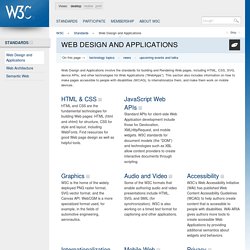
To that end we have experts in various parts of the world documenting typographic requirements and gaps between what is needed and what is currently supported in browsers and ebook readers. The flagship document is Requirements for Japanese Text Layout. Before and After Demonstration: Overview. About the Demo The Before and After Demonstration is a multi-page resource that shows an inaccessible website and a retrofitted version of this same website.

Each web page includes inline annotations that can be activated to highlight some of the key accessibility barriers or repairs. Each web page is also accompanied by an evaluation report to inform the developers on the level of conformance to the Web Content Accessibility Guidelines (WCAG). Why make your Website W3C Compliant. W3C DHTML Introduction - DHTML TUTORIAL. W3C XML Tutorial - XML TUTORIALS. W3C JavaScript Tutorial - BROWSER SCRIPTING. This JavaScript tutorial contains hundreds of "Try it yourself" examples.
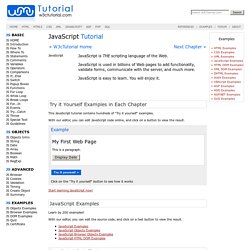
With our editor, you can edit JavaScript code online, and click on a button to view the result. Start learning JavaScript now! Learn by 200 examples! With our editor, you can edit the source code, and click on a test button to view the result. Test your JavaScript skills at W3cTutorial! Start JavaScript Quiz! At W3cTutorial you will find a complete reference of all JavaScript objects, Browser objects, and the HTML DOM objects. The HTML Certificate documents your knowledge of HTML.
The CSS Certificate documents your knowledge of advanced CSS. The JavaScript Certificate documents your knowledge of JavaScript and HTML DOM. The jQuery Certificate documents your knowledge of jQuery. The XML Certificate documents your knowledge of XML, XML DOM and XSLT. The ASP Certificate documents your knowledge of ASP, SQL, and ADO. The PHP Certificate documents your knowledge of PHP and SQL (MySQL). A Typical HTML Page.
When doing DOM-based performance testing you frequently need to pick a sample HTML document to work against. This raises the question: What is a good, representative, HTML document? For many people a good document seems to file into one of two categories: A large web page with a lot of content. When we did our initial performance testing with jQuery we used Shakespeare's As You Like It (lots of elements, but a very flat structure) - Mootools uses an old draft of the W3C CSS3 Selectors recommendation. A Typical HTML Page. When doing DOM-based performance testing you frequently need to pick a sample HTML document to work against. This raises the question: What is a good, representative, HTML document?
The Common Gateway Interface. The Common Gateway Interface, or CGI, is a standard for external gateway programs to interface with information servers such as HTTP servers. The current version is CGI/1.1. CGI Documentation If you have no idea what CGI is, you should read this introduction. Once you have a basic idea of what CGI is and what you can use it for, you should read this primer which will help you get started writing your own gateways. If you are interested in handling the output of HTML forms with your CGI program, you will want to read this guide to handling forms with CGI programs. Security is a crucial issue when writing CGI programs. Hypermedia Definition. 3.1 What is hypertext and hypermedia? Heuristic Evaluation Articles and Training. July 6, 2014 Showing users things they can recognize improves usability over needing to recall items from scratch because the extra context helps users retrieve information from memory.
Web Technologies Statistics and Trends. Select one of the technologies listed on the left to get the survey on the technology usage statistics.
Storyboarding - Layout and Navigation - Planning - Web Authoring Resource Center - Cal Poly.